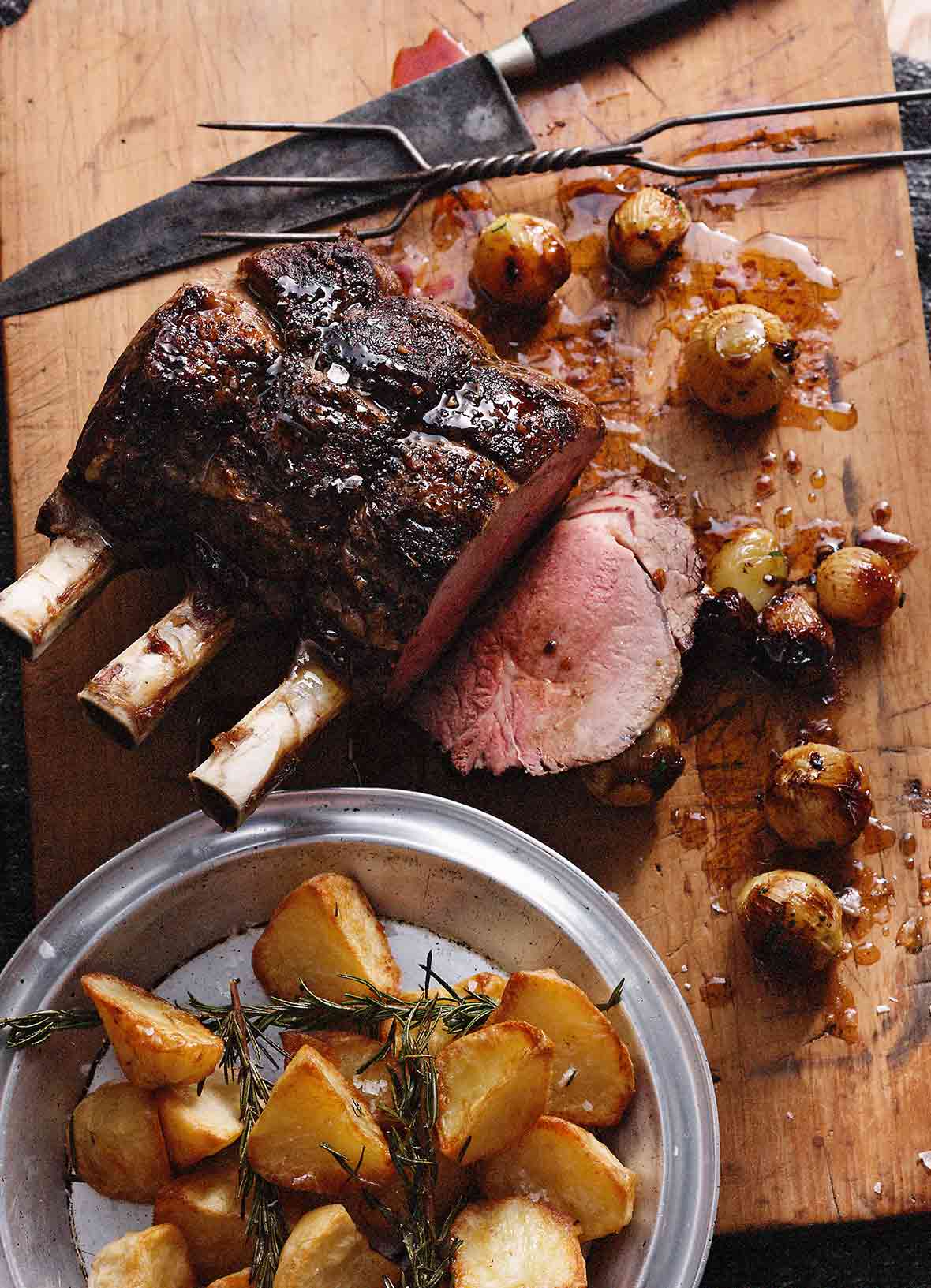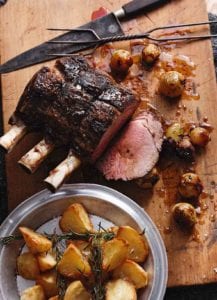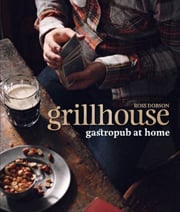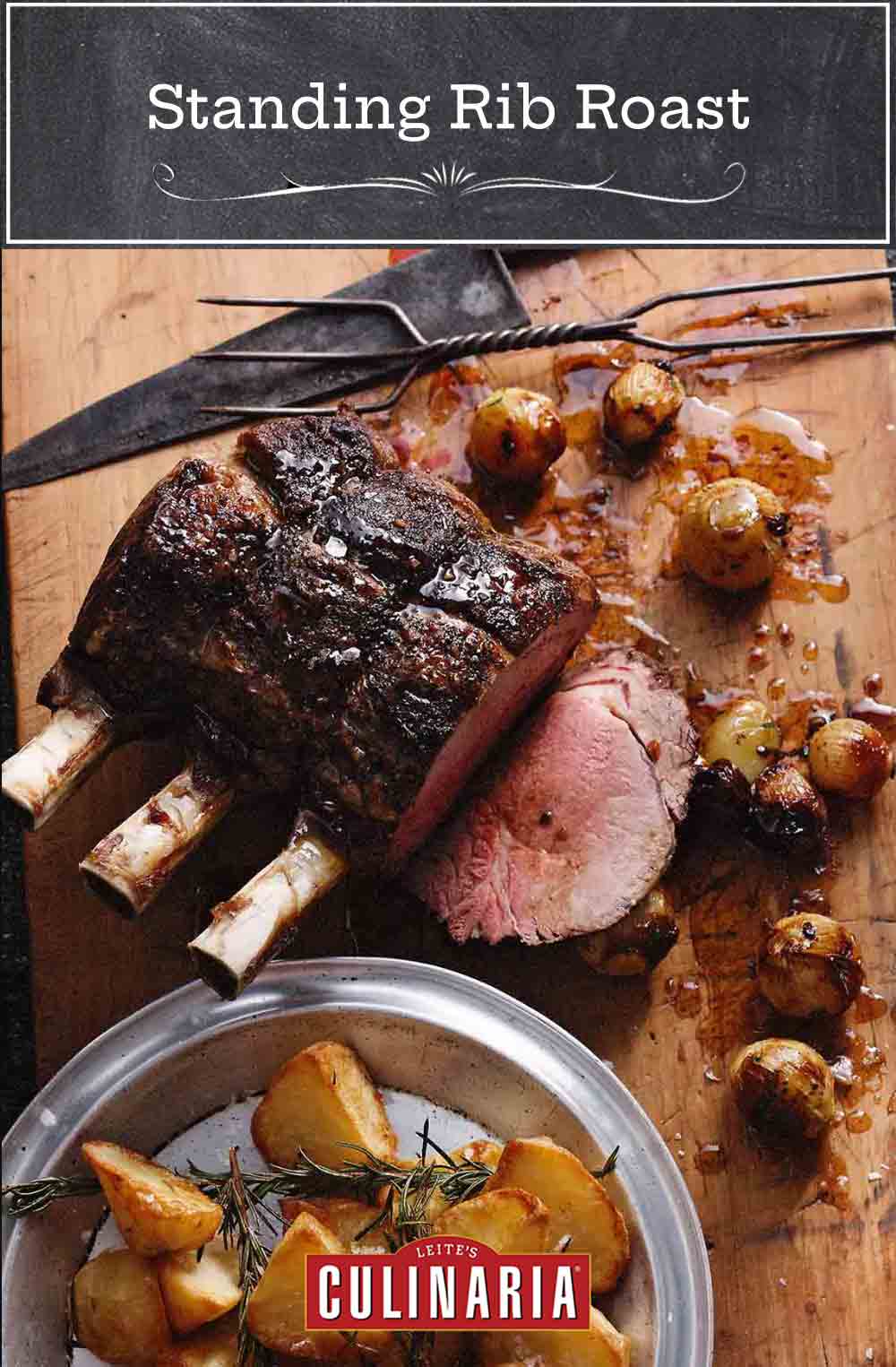
A classic standing rib roast is essentially several unsliced bone-in rib eye steaks, standing on end alongside one another in an impressive formation worthy of the most special of occasions. And the taste? Trust us, there are far worse things to tuck into for dinner, whether Sunday supper or a Christmas feast. Here’s how to cook it.–Renee Schettler Rossi
Is there a difference between standing rib roast and prime rib?
Not really. They’re the same luxuriously indulgent cut of meat, which is also, confusingly, sometimes labeled “prime rib roast” or “rib roast.” It’s the same cut of beef that, when sliced into steaks, is known as rib eye, whether it’s left on the bone or boneless.

Standing Rib Roast
Ingredients
- 1 standing rib roast with 4 bones (at least 3 1/2 lbs [1.6 kg] and quite possibly more), frenched, if desired
- 1 tablespoon coarse sea salt
- 2 teaspoons freshly ground black pepper
- 5 1/2 tablespoons (2 1/4 oz) unsalted butter
- 2 tablespoons olive oil
- 12 small fresh pearl onions, peeled
- 3 cloves garlic, finely chopped
- Handful flat-leaf parsley leaves, finely chopped
Instructions
- Remove the standing rib roast from the refrigerator and place it on a wire rack set on a plate. In a small bowl, combine the salt and pepper and rub it all over the beef. Let rest at room temperature for 1 hour.
- Preheat the oven to 300°F (148°C).
- In a large, ovenproof skillet or roasting pan over medium-high heat, heat half the butter and half the oil until almost but not quite smoking. Add the beef, top-side down, and sear, without moving, for 4 to 5 minutes.
- Carefully turn it over and cook for another 5 minutes. Remove the meat from the pan and carefully pour off the hot fat that’s in the pan.
- Carefully add the remaining butter and oil to the pan and return it to medium-high heat, tilting the pan and swirling the butter so it sizzles. Add the onions and garlic and toss to coat in the butter.
- Nudge the onions and garlic to the side of the pan and place the standing rib roast in the center, top-side up. Place the pan in the oven and roast, stirring the onions from time to time, until the roast reaches the desired doneness, about 1 hour for medium-rare, or 135°F to 140°F (57°C to 60°C) on an instant-read thermometer.
- Move the standing rib roast to a cutting board, set it in a warm place, and let it rest, uncovered, for 10 to 15 minutes.
- Meanwhile, if desired, spoon any excess fat from the surface of the pan juices and discard. Add the parsley to the onions in the pan and stir to coat with the juices. Return the pan to the turned-off oven to keep the juices warm while the roast rests. Tip any juices from the cutting board into the pan with the onions and stir to combine.
- Carve the roast between the ribs to yield 4 portions of meat with a bone in each. Spoon the onions and juices over the meat or pass them on the side.

Nutrition
Nutrition information is automatically calculated, so should only be used as an approximation.
Recipe Testers’ Reviews
This standing rib roast recipe knocked our socks off. It’s so simple and yet prepares a perfectly cooked, perfectly seasoned piece of meat. I added small potatoes to the pan with the onions and they came out perfectly cooked. Are you sensing a theme here? This recipe is perfection!
Let me start by saying that I was unable to find a standing rib roast so I got 3 nice-size bone-in rib eyes. I followed the recipe to a T, apart from a slightly shorter time in the oven. The final product was outstanding. Simple in taste and the beef was cooked to perfection.
It’s very easy to make and will definitely wow your family and/or guests. I can see this being the perfect meal for a special occasion such as Thanksgiving (if you’re not into turkey) or Christmas.













Yes, there is a way to extend your au jus. Do your roast on a rack over a shallow lipped roasting pan. Into the pan, before you place the rack in place, place a variety of vegetables such as sliced carrot, diced onion, garlic left unpeeled, celery, mushrooms for umami and Worcestershire sauce for more umami, some salt and pepper, beef stock if you have it, or beef bullion granules and water or dry red wine. When you roast the meat the meat juices and fat will drip into the broth. You will have created an au jus and extended the volume yet you will still have the flavor of the meat. I have known kitchens where they save the celery leaves and potato peels and carrot peels, mushroom stems, onion peelings, all of which are cleaned and washed, and this goes into the bottom of the roasting pan with seasonings. After the roast is done roasting, the solids are strained out and the au jus is checked for flavor and is thickened with anything you want, flour, corn starch, arrow root then used as a gravy.
Stu, thank you very much my friend.
I truly appreciate you taking the time to reply and I will be looking forward to making my friend this amazing looking roast.
Regards, Dan
I love when strangers help one another. Love it.
Would someone let me know how I can make extra juices—au jus—for the garlic mashed potatoes? Thank you.
Hawkeye, we’re a little stumped as to how to make extra juices without diluting the insanely flavorful jus that comes from the roast. You could, of course, add some homemade beef stock if you had it on hand, but again, that’s going to dilute the essence of the jus. So aside from sizzling up another roast, we can’t say. Anyone else have an idea?
We usually make one of these every Christmas day. We’ve never gone wrong with our standard recipe. BUT show me any piece of meat seared in butter and I’m game to try something new. This recipe will be in our oven this 12/25. Yum!
Heh, Grace, love the way you think—and cook. Do let us know how it compares, and a merry, merry Christmas to you and yours.
This was absolutely wonderful. We used a 16 pound cut of prime rib to ensure we could serve all of our guests, so ours ranged in wellness from medium to medium rare. The flavoring was wonderful and YES, you could taste that hint of wonderful buttery goodness. Despite the extremely large size of our roast and the necessary extended cooking time, it still came out wonderfully moist, tender, and flavorful. The pearl onions were a wonderful accompaniment to the roast and made an amazingly savory addition when eaten in conjunction with spoonfuls of my homemade cranberry sauce. 🙂 I would highly recommend this recipe to anyone who asks me, with no alterations to seasonings at all except for adjustments in ingredients to match the larger proportions of the cut of meat.
Wonderful, Grace! Many thanks for letting us know. We so appreciate it. Happy, happy New Year!